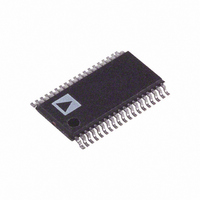AD5348BRUZ Analog Devices Inc, AD5348BRUZ Datasheet - Page 11

AD5348BRUZ
Manufacturer Part Number
AD5348BRUZ
Description
IC DAC 12BIT OCTAL VOUT 38-TSSOP
Manufacturer
Analog Devices Inc
Datasheet
1.AD5348BRUZ.pdf
(24 pages)
Specifications of AD5348BRUZ
Data Interface
Parallel
Settling Time
8µs
Number Of Bits
12
Number Of Converters
8
Voltage Supply Source
Single Supply
Power Dissipation (max)
8.3mW
Operating Temperature
-40°C ~ 105°C
Mounting Type
Surface Mount
Package / Case
38-TSSOP
Resolution (bits)
12bit
Sampling Rate
125kSPS
Input Channel Type
Parallel
Supply Voltage Range - Analog
2.5V To 5.5V
Supply Current
1mA
Digital Ic Case Style
TSSOP
Number Of Channels
8
Resolution
12b
Conversion Rate
125KSPS
Interface Type
Parallel
Single Supply Voltage (typ)
3.3/5V
Dual Supply Voltage (typ)
Not RequiredV
Architecture
Resistor-String
Power Supply Requirement
Single
Output Type
Voltage
Integral Nonlinearity Error
±16LSB
Single Supply Voltage (min)
2.5V
Single Supply Voltage (max)
5.5V
Dual Supply Voltage (min)
Not RequiredV
Dual Supply Voltage (max)
Not RequiredV
Operating Temp Range
-40C to 105C
Operating Temperature Classification
Industrial
Mounting
Surface Mount
Pin Count
38
Package Type
TSSOP
Lead Free Status / RoHS Status
Lead free / RoHS Compliant
Lead Free Status / RoHS Status
Lead free / RoHS Compliant, Lead free / RoHS Compliant
Available stocks
Company
Part Number
Manufacturer
Quantity
Price
Part Number:
AD5348BRUZ
Manufacturer:
ADI/亚德诺
Quantity:
20 000
Offset Error Drift
This is a measure of the change in offset error with changes in
temperature. It is expressed in (ppm of full-scale range)/°C.
Gain Error Drift
This is a measure of the change in gain error with changes in
temperature. It is expressed in (ppm of full-scale range)/°C.
DC Power-Supply Rejection Ratio (PSRR)
This indicates how the output of the DAC is affected by changes
in the supply voltage. PSRR is the ratio of the change in V
a change in V
in dB. V
DC Crosstalk
This is the dc change in the output level of one DAC at midscale
in response to a full-scale code change (all 0s to all 1s and vice
versa) and output change of another DAC. It is expressed in µV.
Reference Feedthrough
This is the ratio of the amplitude of the signal at the DAC
output to the reference input when the DAC output is not being
updated, i.e., LDAC is high. It is expressed in dB.
Channel-to-Channel Isolation
This is a ratio of the amplitude of the signal at the output of one
DAC to a sine wave on the reference inputs of the other DACs.
It is measured by grounding one V
4 V p-p sine wave to the other V
Major-Code Transition Glitch Energy
This is the energy of the impulse injected into the analog output
when the DAC changes state. It is normally specified as the area
of the glitch in nV-s and is measured when the digital code is
changed by 1 LSB at the major carry transition (011 . . . 11 to
100 . . . 00 or 100 . . . 00 to 011 . . . 11).
Digital Feedthrough
This is a measure of the impulse injected into the analog output
of the DAC from the digital input pins of the device, but it is
measured when the DAC is not being written to, CS held high.
It is specified in nV-s and is measured with a full-scale change
on the digital input pins, i.e., from all 0s to all 1s and vice versa.
REF
is held at 2 V and V
DD
for full-scale output of the DAC. It is measured
DD
REF
is varied ±10%.
REF
pins. It is expressed in dB.
pin and applying a 10 kHz,
OUT
Rev. 0 | Page 11 of 24
to
Digital Crosstalk
This is the glitch impulse transferred to the output of one DAC
at midscale in response to a full-scale code change (all 0s to all
1s and vice versa) in the input register of another DAC. It is
expressed in nV-s.
Analog Crosstalk
This is the glitch impulse transferred to the output of one DAC
due to a change in the output of another DAC. It is measured by
loading one of the input registers with a full-scale code change
(all 0s to all 1s and vice versa) while keeping LDAC high. Then
pulse LDAC low and monitor the output of the DAC whose
digital code was not changed. The area of the glitch is expressed
in nV-s.
DAC-to-DAC Crosstalk
This is the glitch impulse transferred to the output of one DAC
due to a digital code change and subsequent output change of
another DAC. This includes both digital and analog crosstalk. It
is measured by loading one of the DACs with a full-scale code
change (all 0s to all 1s and vice versa) with the LDAC pin set
low and monitoring the output of another DAC. The energy of
the glitch is expressed in nV-s.
Multiplying Bandwidth
The amplifiers within the DAC have a finite bandwidth. The
multiplying bandwidth is a measure of this. A sine wave on the
reference (with full-scale code loaded to the DAC) appears on
the output. The multiplying bandwidth is the frequency at
which the output amplitude falls to 3 dB below the input.
Total Harmonic Distortion (THD)
This is the difference between an ideal sine wave and its
attenuated version using the DAC. The sine wave is used as the
reference for the DAC, and the THD is a measure of the
harmonics present on the DAC output. It is measured in dB.
AD5346/AD5347/AD5348














